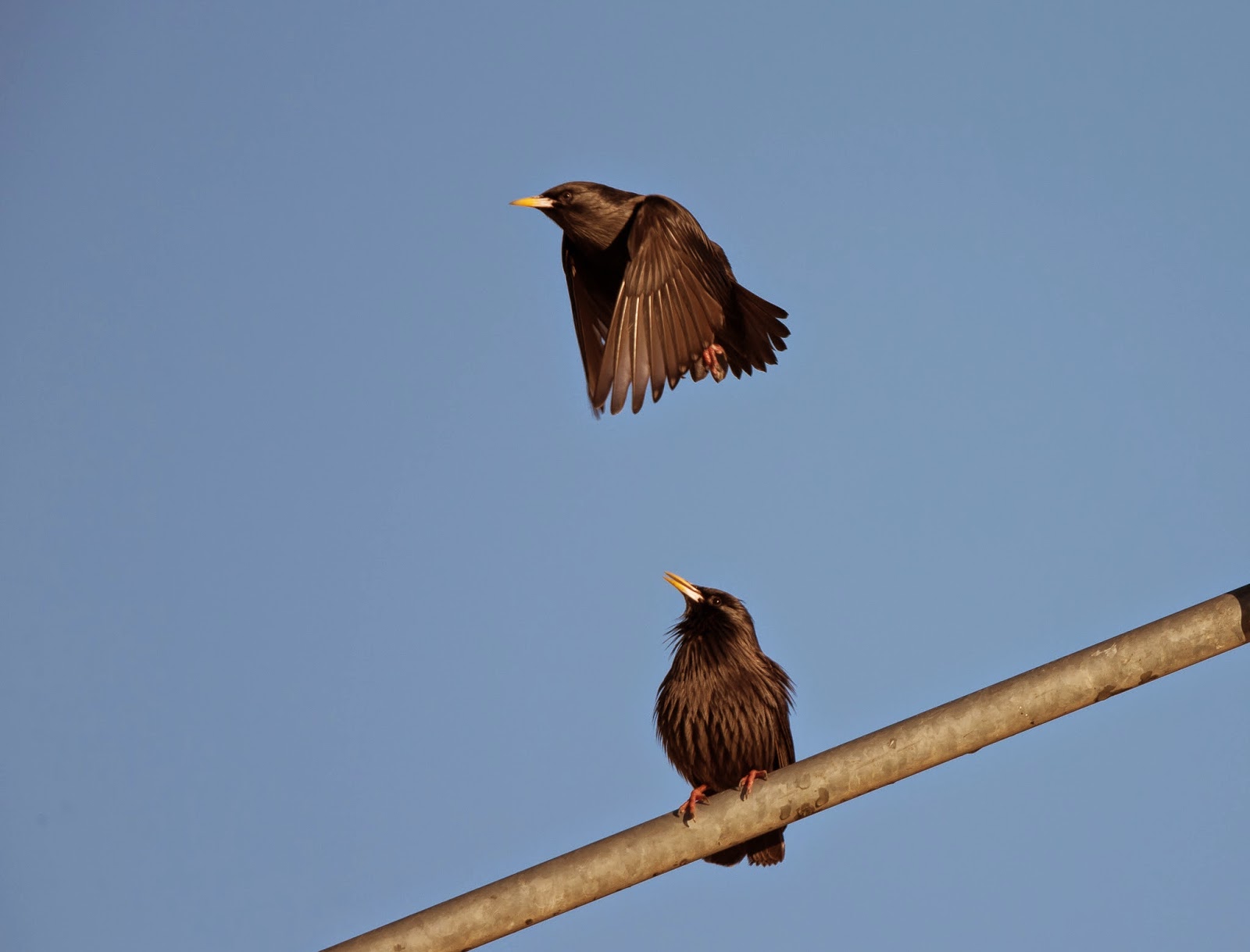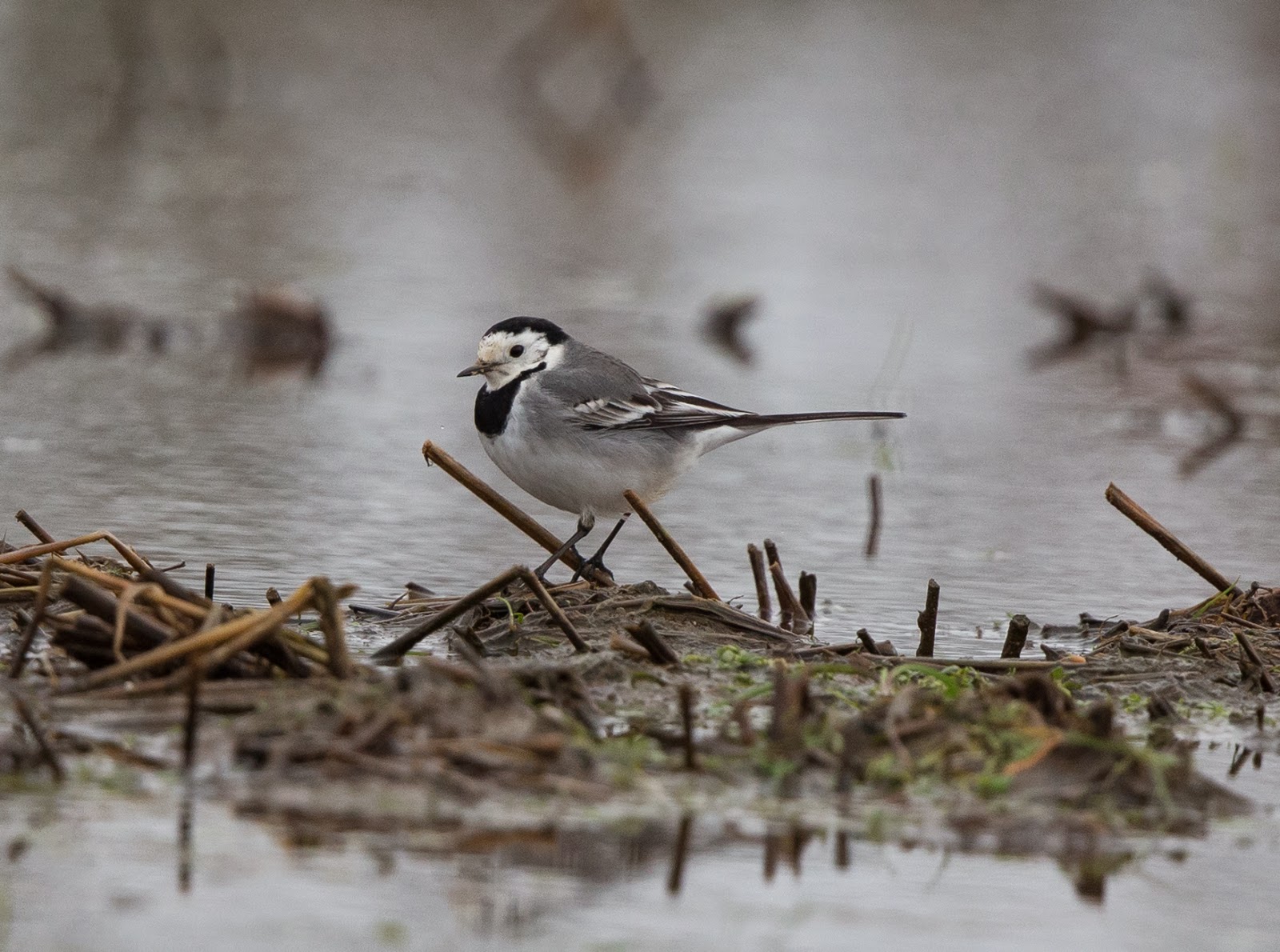I was up at 07:30 for a 08:00 breakfast and out on the road 8:30 just as it was
getting light. Ricardo de-iced the car while I watched Spotless Starling
singing from the town aerials in the half light. We drove out of the village and into a landscape
of grassland with scattered Holm Oak and areas grazed by sheep and cattle
but frozen white by a hard overnight frost.
Frozen steppe just outside La Aldea del Obispo
The car thermometer showed -4c as we
drove at pace along a gravel track across the steppe heading for Richardo's
main site occasionally screeching to a halt for the likes of Crested Lark, Hen
Harrier and Iberian (Southern) Grey Shrike, large numbers of Meadow Pipit, Red
Kite, Corn Bunting and Spanish Sparrow were seen with no stops. We eventually met the EX 390 road and turned
left. As we drove, to our right could be seen a large area of open steppe, an area known as Cuatro Lugares this
was our target birding area. A flock of 30 Great Bustard and 20 Common Crane flashed by at 50
miles an hour but Ricardo assured me we would get better views of these species, we turned right on a track signed for Santiago del Campo and the
pace of the drive slowed. There were many hundreds of lark in the fields with
our first Calandra Lark with several flocks of 50+ encountered. We drove to a
ridge top, the intention being to walk towards the flock of 30 Great Bustard we
had seen from the road but the fog came in and we could see little more than
100m so back to the car and a slow drive across the steppe. A grating sound from
the car caused a stop and while Richardo retrieved a piece of plastic wedged
under the car I scanned the steppe, a flock
of birds on a ridge line, Pin-tailed Sandgrouse, about 80 of them, a fantastic
looking bird. After some digi-scoped pictures in the fog we decided to try
and wander a little bit closer but didn't get far before the flock was up and
circling the steppe looking for a less disturbed place to land. And then a flock
of Black-bellied Sandgrouse went over, about 20 in all. And then a group of
three Common Crane. It was great birding. We spent the rest of the morning driving
this area seeing large numbers of birds, new species for the list included a
showy Dartford Warbler, Black Vulture, Griffon Vulture, Golden Plover, a selection
of familiar ducks including Teal, Wigeon and Shoveler. The fog lifted so we decided to
try for the Great Bustard once more and as we headed across the ridge top we
could see the flock in the distance, we digi-scoped them although they were still at
great distance but these wary birds took flight and flew across the landscape
to settle in an area they clearly felt safer. We watched as they wandered around looking rather stately and occasionally breaking into half displays with wings and tails
spread.
It was time to head towards Monfrague National Park, a drive of approximately 45 minutes, as we left a flock of 14 Little Bustard circled overhead and a Peregrine was new for the list while Common Crane and Black Redstart were common roadside birds.
Open expanse of the steppe habitat at Cuatro Lugares the open vistas resulted
in many species being very wary of close approach
Pin-tailed Sandgrouse - Part of the flock of 80
Pin-tailed Sandgrouse - The males are stunning birds
Pin-tailed Sandgrouse taking flight
Iberian (Southern) Grey Shrike - A common bird
Dartford Warbler
Black-bellied Sandgrouse - We didn't get good views of these on the ground
Calandra Lark - Abundant but wary
Calandra Lark - In song flight showing the distinctive black underwing
Common Crane
Great Bustard - 14 of the flock of 30 present
Great Bustard - Very wary birds, these flushed at a distance of 300m+
Black Redstart
We climbed and wound our way
through the Holm Oak clad slopes of the approach to Monfrague National Park and eventually entered the park. Large areas
of the park appeared to have been stripped bare and Ricardo explained that this
was an attempt to clear the large amount of Eucalyptus that had been planted to
serve a paper mill. We stopped for lunch at the pic-nic site at Los Saltos de Torrejon and Ricardo
sacrificed some of his sandwiches to the Iberian Azure-winged Magpie and it was
not long before at least 20 birds appeared and gave great views. Also here were
a number of Hawfinch that could be heard 'ticking' away in the woodland but
only one showed. We climbed up towards Portilla del Tietar where a Spanish Imperial
Eagle sat atop the cliff showing well but distantly while tens of Griffon
Vultures squabbled on the cliffs below, they looked far more graceful when
soaring around the cliff face then their quarrelsome nature implies. We began a
slow drive out of the park stopping at a few spots, new birds included Crested
Tit and a fine pale Bonelli's Eagle perched distantly on a pylon. Finally, we
spent the last hour of daylight at Monfrague Castle enjoying the stunning views
across the landscape and very close views of Griffon Vultures. Also here were
Rock Bunting, Firecrest, Black Redstart, Sardinian Warbler and Red-billed
Chough. We headed back to the accommodation after a great days birding.

Iberian Azure-winged Magpie
Spanish Imperial Eagle - Views were fairly distant at Portilla del Tietar
View from Monfrague Castle across the Holm Oak dominated landscape
Griffon Vulture - These are early nesting birds and some were already incubating
eggs, this bird is freshening the nest with Holm Oak leaves
Griffon Vulture - Good views were obtained at Monfrague Castle
Rock Bunting at Monfrague Castle
Black Redstart at Monfrague Castle
Here are the links to the other days of the trip:
























































